Living in a Mexican Neighborhood
The Corner of Calle Corona & Miramar
“Aren’t you afraid to live in Mexico? Is it safe? What’s it like to live there? Do you speak Spanish?” One gets a bit tired of answering the same questions after telling someone that we live in Mexico, but everyone seems curious about life here. Here’s the short answer: No, Yes, Very Good, and No. A more descriptive answer requires getting a sense of what day-to-day life is like. How do I do that?
Hmm.
Watching YouTube videos only gets you the tourist-eye view. For us, day-to-day life in the El Cerro neighborhood of Puerto Vallarta takes place within steps of the intersection of Calle Corona and Miramar. It’s just one corner in one neighborhood, so it can’t possibly be representative of life in Mexico. Or can it?
I guess we need to start with the basics – where and what is Puerto Vallarta? Puerto Vallarta lies on a half-moon shaped bay just beneath the Sierra Madre mountains, in the center of the Bay of Banderas on the Pacific shore of Mexico. Once a mining town, then a fishing village, and now a major tourist destination, Vallarta attracts Canadian snow birds, gringos, Europeans, inland Mexicans seeking an ocean vacation, cartel members, billionaires in huge yachts, and on-the-run Americans.
Like many Mexican towns, Vallarta is bright and cheery on the outside, but dimly lit below the surface. It’s essentially lawless on the important stuff. Oh sure, petty crimes are pursued vigorously, taxes are collected, late night parties are sometimes quieted, and speeding tickets are given to many. Yet, for some, laws don’t govern what happens. Condos go up past the height limit with no fuss, people “disappear” with no trace or mention, mayors and governors own monopolies without restrictions (think taxis), and gangsters kill each other in broad daylight with no worry of being caught, let alone punished. The best way to stay on the bright and cheery side is to make sure you don’t walk on the wild side.
The El Cerro neighborhood of Vallarta clings to the hills above El Centro. Made up of tiny streets, walkways, alleys,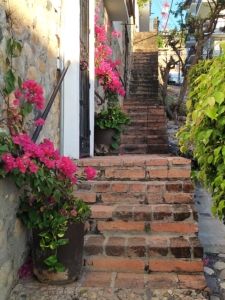 a funicular or two, and an endless number of stairs, it’s the oldest barrio in Vallarta. Most of the houses – everything from shacks to multimillion dollar villas — are open to the city’s prying eyes. It’s too hot in Vallarta to live inside, so most of us live in indoor/outdoor houses so close together that one can knows what programs Grandma across the street is watching.
a funicular or two, and an endless number of stairs, it’s the oldest barrio in Vallarta. Most of the houses – everything from shacks to multimillion dollar villas — are open to the city’s prying eyes. It’s too hot in Vallarta to live inside, so most of us live in indoor/outdoor houses so close together that one can knows what programs Grandma across the street is watching.
We live in the older, less prosperous section of El Cerro. Entire generations of Mexican families live in the same adobe house that their ancestors have occupied since the early 1900s. We know our neighbors and they know us, even though we speak little to no Spanish and they speak little to no English. We live totally different lives, yet, somehow, we figure things out and take care of one another.
Sprinkled throughout the hood are a few expats like us full-timing it. While most seem to be retired, there’s a bunch of us working from home. Most expats are not the well-off retirees of Gringo Gulch or Conches Chinas (the equivalent of PV’s Beverly Hills or Brentwood), but rather working class folks who’ve found their place in the sun and a way to make living here sustainable. Others look to be escaping from something, someone, or some life, keeping a very low profile. Airbnb has turned this residential neighborhood into an off-the-beaten path vacation destination like almost everywhere else. This gives us a supply of fresh faces walking down the street to check out.
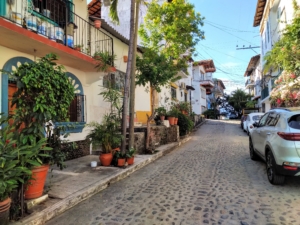 El Cerro contrasts sharply with the neighborhoods either to the north or south. South across the Rio Quale river is the Romantic Zone, Vallarta’s main tourist playground. Known as one of the best gay cities in the world, its usually party time any time on its beach, restaurants, bars, and cabarets. It’s good for a night out as Vallarta has some of the best restaurants we’ve ever been to.
El Cerro contrasts sharply with the neighborhoods either to the north or south. South across the Rio Quale river is the Romantic Zone, Vallarta’s main tourist playground. Known as one of the best gay cities in the world, its usually party time any time on its beach, restaurants, bars, and cabarets. It’s good for a night out as Vallarta has some of the best restaurants we’ve ever been to.
Immediately north of us is 5th of December, named for Mexico’s revolution. Mostly working class Mexicans sprinkled with working class gringos, it’s the place for hardware, appliances, auto parts, two funeral parlors, and the city’s best street food.
The corner of Calle Corona and Miramar, with its uneven cobblestones below and gordian knot of wires overhead, is the heartbeat of our part of El Cerro. Accessible from the north only by a street so perilously steep that most neighborhood residents avoid driving up it. To the south, Miramar’s uneven cobblestones undulate for five or so blocks (is anything level in Mexico?) between its mishmash of houses, apartments, villas, a five-star hotel and our bodega. Despite its narrowness and potholes that require a snail’s pace to not break a wheel, it’s one of the busiest streets in all El Centro as it’s one of only two southbound streets through downtown.
Calle Corona, also a main artery of this hillside enclave, runs uphill from the ocean in the West to the top of the peaks behind our house. Like most of the streets and alleyways in El Cerro, it converts from street to stairs without much of a warning. Streets here are so narrow that any wrong turn usually requires backing down as there is no room to turnaround.
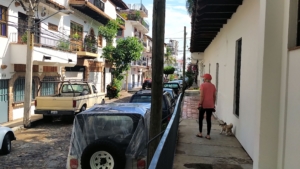 All manner of vehicles pass below our living room windows overlooking this corner. Cars, pickups, SUVs, motorcycles, trash trucks, gas trucks, taxis, police vehicles, ATVs and cement trucks rattle, bark, growl, and squeak by us at all hours of the day and night. Since our second floor overhangs Corona a bit, neighbors often help larger trucks navigate so they don’t’ take another chunk of the house or one of four telephone poles on the corner. Our neighborhood is tight.
All manner of vehicles pass below our living room windows overlooking this corner. Cars, pickups, SUVs, motorcycles, trash trucks, gas trucks, taxis, police vehicles, ATVs and cement trucks rattle, bark, growl, and squeak by us at all hours of the day and night. Since our second floor overhangs Corona a bit, neighbors often help larger trucks navigate so they don’t’ take another chunk of the house or one of four telephone poles on the corner. Our neighborhood is tight.
I’m not sure why, but most buildings in El Cerro are painted white, usually with some color or tile work as trim. I used to hate it as it seemed so bland, but now I’ve come to like it as all the buildings and streets glow from the ever present sun. You can’t help but be in a better mood when everything sparkles. Upon closer inspection, while most houses are white, they are very different because of trim colors, window shapes, tile work, wrought iron railings, etc. Construction and size also differentiate. Small brick and adobe houses still squeeze in between newer, larger structures. A few are continuously “improved” as fast as money allows with new floors, walls and windows slowly popping up.
Our house, “Corona Adobe,” is one of the outliers in the neighborhood. It’s hard to miss as it sits on the corner, is one of the bigger single family units, and is painted a pale yellow with patches of old abode brick still exposed. Its either a sore thumb or a gem depending on your taste. It started out as a low, one story adobe home and stable built around 1900. It became the seventh house on the electrical grid shortly thereafter and pictures of it in the 60s show little change. Around 2000 it was modernized on the inside, retaining its adobe hut look on the outside.
We tripled its size in 2012 adding two floors, a pool and observation deck. At first, our neighbors viewed us as sinners for demolishing a large part of the original house. Over time it began to blend in with the neighborhood as did we. Now, it’s a regular stop on tourist walks through the neighborhood.
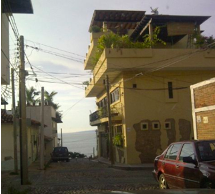 Our neighbors immediately to the west are Carmen and Eduardo and their extended family. By extended, I mean Carmen/Eduardo, their two daughters, their six kids, their grandmother, two tea-cup Chihuahuas and frequent visits from other members of the family. Their house is two stories not much wider than a one-car garage, crunched in between our house and the behemoth condo next door. Tight, very tight.
Our neighbors immediately to the west are Carmen and Eduardo and their extended family. By extended, I mean Carmen/Eduardo, their two daughters, their six kids, their grandmother, two tea-cup Chihuahuas and frequent visits from other members of the family. Their house is two stories not much wider than a one-car garage, crunched in between our house and the behemoth condo next door. Tight, very tight.
All social activity in the barrio takes place on the street, usually on the steps or sidewalk in front of each house. It’s also where Eduardo fixes everything from refrigerators, TVs, BBQs, various pieces of furniture and anything that needs to be repaired on his maroon Subaru station wagon. He has the fullest set of tools in the neighborhood. The man can fix anything and is a constant source of amazing ingenuity.
Eduardo, Carmen, my wife Karen, and I have shared many tequilas on the stoop in front of their house at all hours of the night. We speak almost no Spanish and they speak almost no English, but it doesn’t seem to matter, especially after a tequila or two.
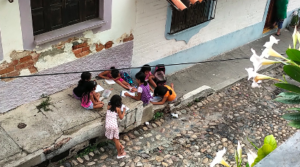
Like almost every family we’ve met in Mexico, they’ve been touched by drugs. Our neighbor’s son was a low level dealer who didn’t come home one night. Ever. Another son struggles with addiction and no longer lives at home. Whether it’s a brother, son, uncle, or sister, most everyone in Mexico knows someone who is/was in the drug business. Gringos think of El Chapo and other horrific cartels when thinking of drug dealers. That’s not what it looks like at ground level here in El Cerro.
At the next intersection up from our house, which is maybe 50 feet away, dozens of tied together sneakers are thrown over the telephone wires announcing to those in the know that this is a drug dealer’s corner. Transactions are so subtle that I’ve only seen a couple in the ten years we’ve lived here. While the transactions may be subtle, the dealers’ presence is not. Three or four guys are always standing on the corner, either just standing there, or playing their boom boxes, or having one of their frequent parties, or just making noise.
Selling drugs is both subtle and obvious. A motorcycle will pull up, someone steps off the curb, greets the rider, shakes hands, and then said motorcyclist drives off. This happens day and night, with cars, pickups, taxis, and police vehicles taking their turn. Perhaps not surprisingly, the father of one of the dealers is a policeman, hence there isn’t much worry about law enforcement. This has been happening for ten years.
The Main Man periodically sits on the curb or walks about, sometimes coming down the street to the local look-out point, making sure his presence is known. He’s not big, he’s pretty good looking, and wears an expressionless look on his face. I get the vibe that when he gets serious, things get serious. Now that we’ve known each other for a couple of years his face lights up in a smile and we exchange “Buenos Dias, Amigo” whenever I walk the dogs or drive by. It’s taken a while, but it’s always good to be “friends” with the Main Man.
Last night I was standing on our 2nd floor balcony looking up and down the street at around 10PM. More than a dozen kids under the age of twelve were running about, with the girls playing with their doll house and the boys either kicking a soccer ball or laughing on the corner below our house.
Just around the corner Elvira was starting up her street cart offering late night tacos to go with cold Coronas. Elvira’s brother died last week, so a nine-day wake was taking place next to her taco cart, in front of his house. Literally, families live and die in their houses. Friends and relatives were milling about for hours, as the sound of prayers and songs were escaping from the house
Music was coming from all directions. The neighbor’s roosters were crowing in the distance even though it’s night. We have perhaps a half-dozen or so roosters within shouting distance, who seem to have around-the-clock cock-a-doodle dooling schedules. Our dealers were entertaining guests, with what looked like a party on the second floor of their place. Lots of people laughing and moving to the music under the streetlights. The normal assortment of traffic was driving by listening to their radio turned up loud enough to sing along. This kind of night happens two or three times a week. Sometimes it ends early, say 11 o’clock or midnight, and sometimes it goes to 7 in the morning. After a while, it just becomes a background hum.
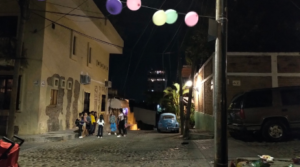
Life inside the walls of Corona feels like a world apart. We hear, smell, and see the outside, but it rarely affects our cocoon.
I spend most of my time in my “office” on the third floor. Most days are spent on Zoom calls with LA, DC, Logan (Australia), West Bengal (India) and several of our 30 members in 14+ countries. Outside the balcony door to my right is our pool and the hills of El Cerro. Straight ahead is a window to the Hotel Zone a mile or so away. There’s a couch in the office too, where the dogs and I take naps. There are days when I don’t come out except for lunch and dinner. It’s at once insular to what’s happening in the world and totally connected to the neighborhood. Sounds and smells remind one where we are.
Little things we take for granted in the States are missing here. There is no mail delivery. The phone company and other utilities send messengers into neighborhoods to deliver their bills. Everyone else calls or texts instead. The only way to send something to/from the U.S. is FedEx or one of their competitors.
The propane truck comes regularly with a speaker announcing its availability. Trash pickup happens a couple times a week, but this isn’t your U.S. style trash system. There are several corners that have been designated as the neighborhood’s trash collection points. I have no idea why these points were chosen. There are no trash cans, so we all just drop our trash bags in said area. Then a larger than normal pickup truck comes by and three guys work the trash: driver, recycling separator and on the trash gatherer. Its messy, but it happens without a hitch several times a week. Each corner is spotless after each stop.
Every morning I take Bogart and Squirt for a walk. All three of us walk carefully on the cobblestones, as we all suffer from tender feet and a lack of coordination. It’s slow going, much like Mexico. It gives one the time to ponder, to enjoy, to take in all the sights, sounds and smells of life. Here’s what I think about on these mornings; its very very good here. We’re very lucky to be here, to have a style of life that moves and grooves as we do.
So, let’s revisit those four questions.
Aren’t you afraid to live in Mexico? I never think about it. We wouldn’t live here if we felt unsafe.
Is it safe? Yes, just don’t walk on the Wild Side.
What’s it like to live there? Strangely enough, it feels like family.
Do you speak Spanish? ¿Puedo tomar otra cerveza Corona, por favor?
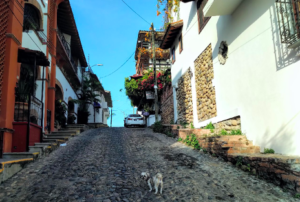

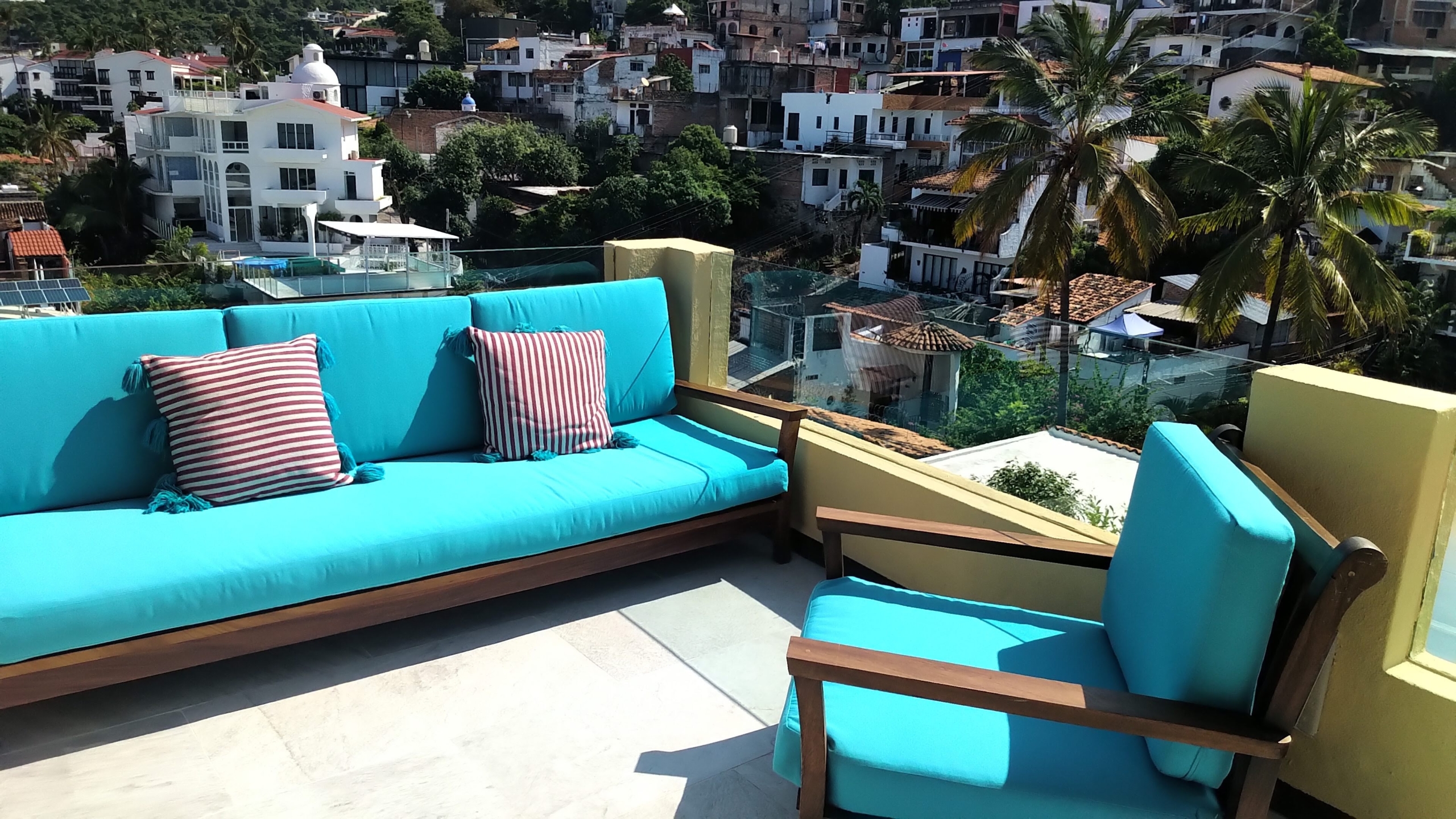

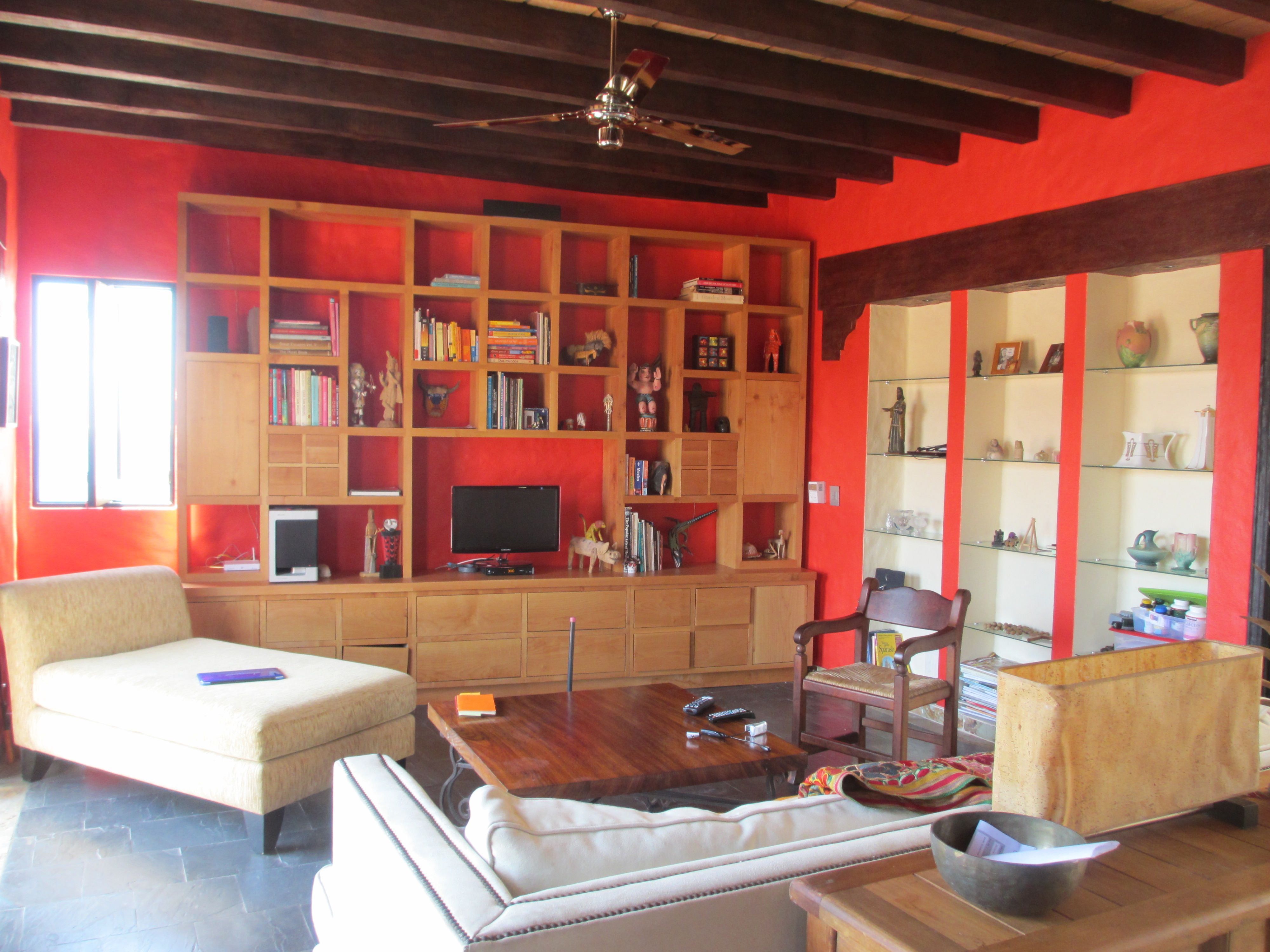
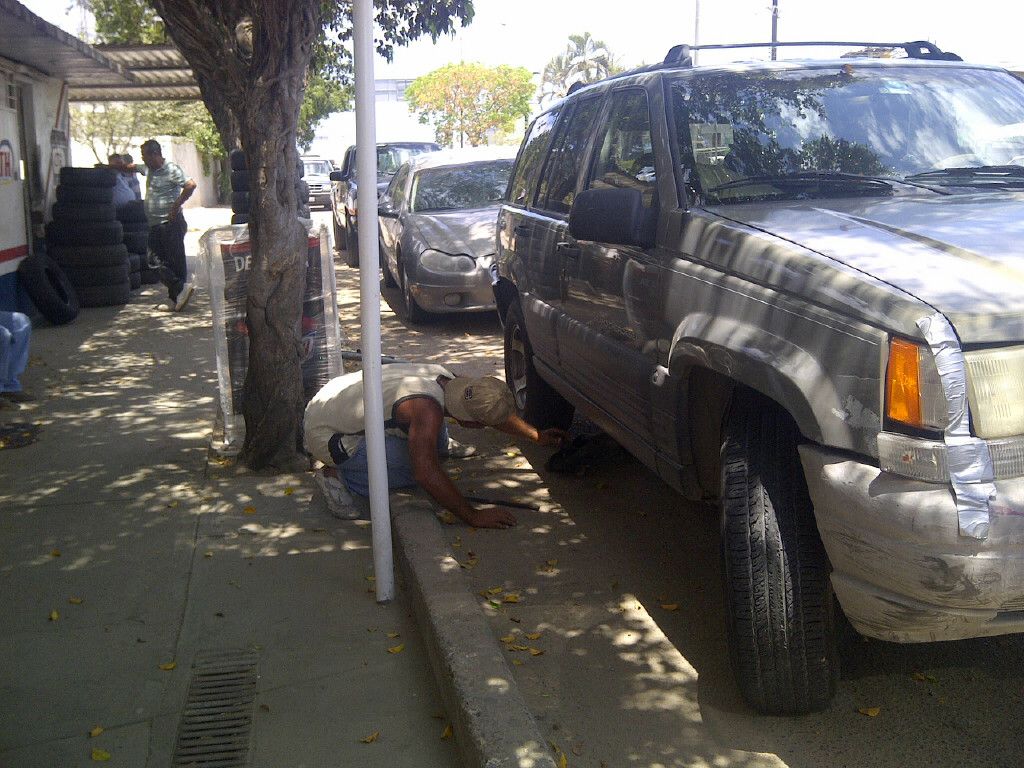


Hola Fred!
We’re long time friends of Basel from Zaire
(Re: 2010, Chasing the Dacar) and he sent us this article. We’re in Puerto Vallarta and did a “cold call” to your home while visiting the Malecon.
The town/streets/hills/foliage remind me of my frequent visits to Charlotte Amalie (St. Thomas) while I was living in Puerto Rico!
Sorry we missed you but love your adopted home area and Jalisco!
Saludos,
Bob and Hülya Cahalan
I remember Basel well! Please give my regards. Seems like a lifetime ago that Basel and I Chased the Dakar. It’s nice to hear from you and hope to see you in the near term. Karen and I now split our time between Puerto Vallarta and Sandia Park, NM. fw
Sorry we missed you but LOVE Puerto Vallarta! If you are ever in the Dallas/Ft. Worth area give us a call. 817-901-3076. It would be fun to share some, “Tales Retold.” (I grew up in Africa, where I went to High School with Basel. Did the “Asia Overland” gig from Munich to Calcutta [spent a month in Nepal] in 1978 during the Iranian Revolution, 14 months before Russians in Afghanistan.) HBCahalan@aol.com
Well, you have come a long way from, “Mas Corona!”
OMG, he rises from the ashes: )) fw